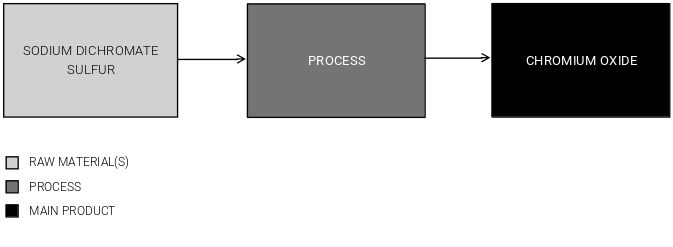Commodity Production Costs Report
Chromium(III) Oxide Production
Chromium Oxide Plant Capital & Operating Cost Analysis | United States | Q3 2025
This report presents the economics of Chromium(III) Oxide production from sodium dichromate and sulfur. The process examined is a typical reduction process. In the process, a mixture of sodium dichromate and sulfur are burned in a furnace, producing Chromium(III) Oxide as product, and sodium sulfate as by-product.
The report provides a comprehensive study of Chromium Oxide production and related Chromium Oxide production cost, covering three key aspects: a complete description of the Chromium Oxide production process examined; an in-depth analysis of the related Chromium Oxide plant capital cost (Capex); and an evaluation of the respective Chromium Oxide plant operating costs (Opex).
The Chromium Oxide production process description includes a block flow diagram (BFD), an overview of the industrial site installations, detailing both the process unit and the necessary infrastructure, process consumption figures and comprehensive process flow diagrams (PFD). The Chromium Oxide plant capital cost analysis breaks down the Capex by plant cost (i.e., ISBL, OSBL and Contingency); owner's cost; working capital; and costs incurred during industrial plant commissioning and start-up. The Chromium Oxide plant operating costs analysis covers operating expenses, including variable costs like raw materials and utilities, and fixed costs such as maintenance, labor, and depreciation.

Product
Chromium Oxide. Chromium Oxide (a.k.a. Chromium(III) Oxide) is an inorganic compound, one of most important oxides of chromium, as the +3 oxidation state is the most stable of chromium. It occurs naturally as the mineral eskolaite, and appears as a green, hard, and brittle material, not readily attacked by acids. The production of commercial Chromium Oxide carried out the reduction of an alkali dichromate in a self-sustaining dry reaction by a reducing agent such as sulfur, carbon, starch, wood flour, or ammonium chloride. Chromium Oxide is used in paints, inks, glasses, and even to colouring cements, due to its stability to alkalies.
Raw Materials
Sulfur. Sulfur is an abundant, multivalent non-metal of great importance in the chemical industry. It is a key raw material, mainly used in the form of Sulfuric Acid and sulfur dioxide. In its elemental form, sulfur is used in the production of carbon disulfide, rubber, pesticides, pharmaceuticals, and cosmetics. Elemental sulfur can be produced from a variety of sources, and through a number of different techniques. It is frequently obtained as by-product from petroleum refining, natural gas processing and coking plants, for instance.
Sodium Dichromate. Sodium dichromate is a powerful oxidizing agent used in chromium plating, pigment production, and leather tanning. It is also utilized in organic synthesis to oxidize alcohols to aldehydes and ketones. Produced from chromite ore and sodium carbonate, it is stored as orange-red crystals. Its role in industrial processes like corrosion protection and textile dyeing has widespread applications, though it is highly toxic and must be handled with care.
Report in PDF Format
Download & Explore Anytime
Access in Various Devices
Print & Read Comfortably
Share With Co-workers
Up-to-date Report
Professional report based on Q3 2025 economic data, ensuring timely evaluations.
Multiple Use Cases
Ideal for investment screening, feasibility studies, cost estimates, and research planning.
Proven Methodology
Developed using a consistent methodology honed over a decade, ensuring reliable cost analyses.
Report Editions
Content Highlights
Plant Capital Cost Summary
Summary outlining the capital cost required for building the Chromium Oxide production plant examined.
Plant Capital Cost Details
Detailing of fixed capital (ISBL, OSBL & Owner’s Cost), working capital and additional capital requirements.
Plant Cost Breakdowns
Breakdown of Chromium Oxide process unit (ISBL) costs and infrastructure (OSBL) costs; plant cost breakdown per discipline.
Operating Costs Summary
Summary presenting the operating variable costs and the total operating cost of the Chromium Oxide production plant studied.
Operating Cost Details
Detailing of utilities costs, operating fixed costs and depreciation.
Plant Capacity Assessment
Comparative analysis of capital investment and operating costs for different Chromium Oxide plant capacities.
Production Process Information
Block Flow Diagram, descriptions of process unit (ISBL) and site infrastructure (OSBL).
Process Consumptions
Raw materials and utilities consumption figures, by-products credits, labor requirements
Process Diagrams
Process flow diagrams (PFD), equipment list and industrial site configuration
Could Not Find the Report You Need?
Obtain a Bespoke Report
Get a report targeting the process in which you are interested
See Offer Details
Understand Bespoke Reports and how you can easily order them
Check Editions & Pricing
Complete a brief form and see a quotation for your Bespoke Report
Other Related Production Cost Reports

Sulfuric Acid from Sulfur (Double-Contact Process)
This report presents the economics of Sulfuric Acid production from sulfur in the United States. In this process, sulfur is burned to form sulfor dioxide, which is then converted to sulfur trioxide. Sulfor trioxide is converted to sulfuric acid by double-contact double absorption (DC/DA) with a high concentration sulfuric acid solution in water.
Details: 1480 kta United States-based plant | Q3 2025 | 107 pages | Issue A | From $799 USD

Methyl Ester Sulfonate Production
This study presents a feasibility analysis of Methyl Ester Sulfonate production from palm oil in the United States. This process is comprised of two steps: initially, methyl ester is formed from palm oil and methanol via transesterification. Then, the methyl ester is sulfonated to final product generation.
Details: 100 kta United States-based plant | Q3 2025 | 107 pages | Issue A | From $799 USD
+800 Reports Developed, Targeting +250 Commodities
Vast Report Library
858 independent and up-to-date reports examining embryonic and established production processes.
Free Sample Reports
Quickly understand the structure and depth of content of our professional reports.

